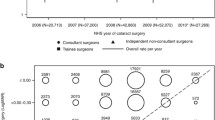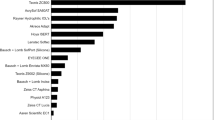Abstract
Purpose
To assess which cases should be assorted exclusively to high-volume surgeons and identify when should a cataract surgeon seek assistance from a senior colleague.
Methods
The medical records of 2853 patients with age-related cataract were reviewed. Preoperative risk factors were documented for each case, and they were divided into surgeons who had more (> 400 surgeries/year) or less experience (< 400 surgeries/year). Ophthalmology residents were excluded from this review. The cases that involved posterior capsule rupture, dropped nucleus, zonular dehiscence and anterior capsular tear with or without vitreous loss were defined as “complicated”.
Results
From the 3247 cataract extraction surgeries that were reviewed, we were unable to identify any statistically significant difference in the complication rates between the two surgeon groups. In the stepwise regression analysis, both groups supported advanced age (> 85) and mature cataracts with up to fourfold odds ratios (OR). Low-volume surgeons had a fivefold OR in the presence of phacodonesis and a fourfold OR in the case of posterior polar cataract. Finally, the low- and high-volume groups had their highest complication rates in the cumulative four and five risk factors, respectively.
Conclusion
In the presence of advanced age, mature cataracts, phacodonesis and posterior polar cataract, the complication rates appear to be higher for the less experienced surgeons. Meticulous preoperative assessment with detailed documentation of each patient’s risk factors can result in fewer complications. The medical complexity of each case can be used as indicator of whether a more experienced surgeon should perform the surgery or not.


Similar content being viewed by others
References
Eurostat ES (2021) Population structure and ageing. In: Increase in the share of the population aged 65 years or over between 2010 and 2020. https://ec.europa.eu/eurostat/statistics-explained/index.php/Population_structure_and_ageing#Past_and_future_population_ageing_trends_in_the_EU. Accessed 9 Oct 2021
Abell RG, Vote BJ (2014) Cost-effectiveness of femtosecond laser-assisted cataract surgery versus phacoemulsification cataract surgery. Ophthalmology 121(1):10–16. https://doi.org/10.1016/j.ophtha.2013.07.056
Busbee BG, Brown MM, Brown GC, Sharma S (2002) Incremental cost-effectiveness of initial cataract surgery. Ophthalmology 109(3):606–613. https://doi.org/10.1016/s0161-6420(01)00971-x
Han JV, Patel DV, Liu K, Kim BZ, Sherwin T, McGhee CNJ (2020) Auckland Cataract Study IV: practical application of NZCRS cataract risk stratification to reduce phacoemulsification complications. Clin Exp Ophthalmol 48(3):311–318. https://doi.org/10.1111/ceo.13696
Gaskin GL, Pershing S, Cole TS, Shah NH (2016) Predictive modeling of risk factors and complications of cataract surgery. Eur J Ophthalmol 26(4):328–337. https://doi.org/10.5301/ejo.5000706
Najjar DM, Awwad ST (2003) Cataract surgery risk score for residents and beginning surgeons. J Cataract Refract Surg 29(10):2036–2037. https://doi.org/10.1016/j.jcrs.2003.08.004
Muhtaseb M, Kalhoro A, Ionides A (2004) A system for preoperative stratification of cataract patients according to risk of intraoperative complications: a prospective analysis of 1441 cases. Br J Ophthalmol 88(10):1242–1246. https://doi.org/10.1136/bjo.2004.046003
Narendran N, Jaycock P, Johnston RL et al (2009) The Cataract National Dataset electronic multicentre audit of 55,567 operations: risk stratification for posterior capsule rupture and vitreous loss. Eye (Lond) 23(1):31–37. https://doi.org/10.1038/sj.eye.6703049
Habib MS, Bunce CV, Fraser SG (2005) The role of case mix in the relation of volume and outcome in phacoemulsification. Br J Ophthalmol 89(9):1143–1146. https://doi.org/10.1136/bjo.2005.070235
Kim BZ, Patel DV, Sherwin T, McGhee CN (2016) The Auckland Cataract Study: assessing preoperative risk stratification systems for phacoemulsification surgery in a teaching hospital. Am J Ophthalmol 171:145–150. https://doi.org/10.1016/j.ajo.2016.09.003
Butler TK (2012) Risk stratification and assessment in cataract surgery. J Cataract Refract Surg 38(1):184. https://doi.org/10.1016/j.jcrs.2011.10.022
Oustoglou E, Tzamalis A, Mamais I et al (2020) Reoperations after cataract surgery: is the incidence predictable through a risk factor stratification system? Cureus 12(9):e10693. https://doi.org/10.7759/cureus.10693
Gandhi JS (2019) Auckland Cataract Study III: refining preoperative assessment with cataract risk stratification to reduce intraoperative complications. Am J Ophthalmol 200:251. https://doi.org/10.1016/j.ajo.2019.01.017
Li EY, Chan TC, Lam NM, Jhanji V (2014) Cataract surgery outcomes in adult patients with Down’s syndrome. Br J Ophthalmol 98(9):1273–1276. https://doi.org/10.1136/bjophthalmol-2013-304825
Lacmanović Loncar V, Petric I (2004) Surgical treatment, clinical outcomes, and complications of traumatic cataract: retrospective study. Croat Med J 45(3):310–313
Wang W, Yan W, Fotis K et al (2016) Cataract surgical rate and socioeconomics: a global study. Invest Ophthalmol Vis Sci 57(14):5872–5881. https://doi.org/10.1167/iovs.16-19894
Halm EA, Lee C, Chassin MR (2002) Is volume related to outcome in health care? A systematic review and methodologic critique of the literature. Ann Intern Med 137(6):511–520. https://doi.org/10.7326/0003-4819-137-6-200209170-00012
Habib M, Mandal K, Bunce CV, Fraser SG (2004) The relation of volume with outcome in phacoemulsification surgery. Br J Ophthalmol 88(5):643–646. https://doi.org/10.1136/bjo.2003.028159
Zetterberg M, Kugelberg M, Nilsson I, Lundström M, Behndig A, Montan P (2020) A Composite Risk Score for capsule complications based on data from the Swedish National Cataract Register; Relation to Surgery Volumes. Ophthalmology. https://doi.org/10.1016/j.ophtha.2020.07.033
Kim JY, Ali R, Cremers SL, Yun SC, Henderson BA (2009) Incidence of intraoperative complications in cataract surgery performed by left-handed residents. J Cataract Refract Surg 35(6):1019–1025. https://doi.org/10.1016/j.jcrs.2009.01.025
Artzén D, Lundström M, Behndig A, Stenevi U, Lydahl E, Montan P (2009) Capsule complication during cataract surgery: Case-control study of preoperative and intraoperative risk factors: Swedish Capsule Rupture Study Group report 2. J Cataract Refract Surg 35(10):1688–1693. https://doi.org/10.1016/j.jcrs.2009.05.026
Nagashima RJ (2004) Decreased incidence of capsule complications and vitreous loss during phacoemulsification in eyes with pseudoexfoliation syndrome. J Cataract Refract Surg 30(1):127–131. https://doi.org/10.1016/S0886-3350(03)00465-6
Hyams M, Mathalone N, Herskovitz M, Hod Y, Israeli D, Geyer O (2005) Intraoperative complications of phacoemulsification in eyes with and without pseudoexfoliation. J Cataract Refract Surg 31(5):1002–1005. https://doi.org/10.1016/j.jcrs.2004.09.051
Blomquist PH, Morales ME, Tong L, Ahn C (2012) Risk factors for vitreous complications in resident-performed phacoemulsification surgery. J Cataract Refract Surg 38(2):208–214. https://doi.org/10.1016/j.jcrs.2011.10.001
Spinelli R, Parrillo L, Longo M, Florese P, Desiderio A, Zatterale F, Miele C, Raciti GA, Beguinot F (2020) Molecular basis of ageing in chronic metabolic diseases. J Endocrinol Invest 43(10):1373–1389. https://doi.org/10.1007/s40618-020-01255-z
McMonnies CW (2017) Glaucoma history and risk factors. J Optom 10(2):71–78. https://doi.org/10.1016/j.optom.2016.02.003
Kiziltoprak H, Tekin K, Inanc M, Goker YS (2019) Cataract in diabetes mellitus. World J Diabetes 10(3):140–153. https://doi.org/10.4239/wjd.v10.i3.140
Canabrava S, Rezende PH, Eliazar GC et al (2018) Efficacy of the Canabrava Ring (pupil expansion device) in cataract surgery for eyes with small pupils: the first 30 cases. Arq Bras Oftalmol 81(3):202–211. https://doi.org/10.5935/0004-2749.20180042
Bucci FA Jr, Michalek B, Fluet AT (2017) Comparison of the frequency of use of a pupil expansion device with and without an intracameral phenylephrine and ketorolac injection 1%/0.3% at the time of routine cataract surgery. Clin Ophthalmol 11:1039–1043. https://doi.org/10.2147/OPTH.S132552
Funding
The authors declare that no funds, grants or other support was received during the preparation of this manuscript.
Author information
Authors and Affiliations
Contributions
All authors contributed to the study conception and design. Material preparation, data collection and analysis were performed by OE, LB, CDC and MS. The first draft of the manuscript was written by OE, and all authors commented on previous versions of the manuscript. All authors read and approved the final manuscript.
Corresponding author
Ethics declarations
Ethics approval
This study was performed in line with the principles of the Declaration of Helsinki. Approval was granted by the Ethics Committee of Aristotle University of Thessaloniki and the Institutional Review Board of Papageorgiou General Hospital.
Competing interests
The authors have no relevant financial or non-financial interests to disclose.
Additional information
Publisher's Note
Springer Nature remains neutral with regard to jurisdictional claims in published maps and institutional affiliations.
Rights and permissions
About this article
Cite this article
Oustoglou, E., Tzamalis, A., Banou, L. et al. When should cataract surgeons seek assistance from experienced colleagues?. Int Ophthalmol 43, 387–395 (2023). https://doi.org/10.1007/s10792-022-02434-y
Received:
Accepted:
Published:
Issue Date:
DOI: https://doi.org/10.1007/s10792-022-02434-y




